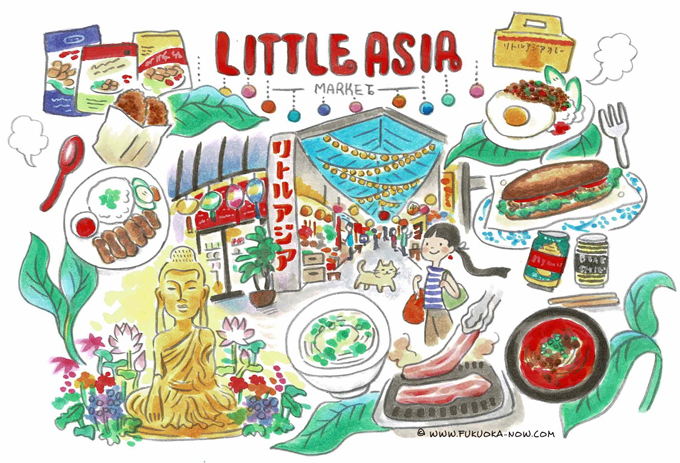Hakata Culture vol.174
Yoshizuka: Take a Stroll through Little Asia

Just a short walk from JR Yoshizuka Station, the Yoshizuka Shopping Street was reopened as the Yoshizuka Little Asia Market at the end of 2020. With restaurants and food stores serving up the flavors of Asian countries like Thailand, Myanmar, China, Vietnam and Korea, the market exudes the feel of a foreign marketplace. There are also shops selling Japanese foods like tofu and kamaboko (fish sausage).
The origins of Yoshizuka Shopping Street date back to the slim times right after World War II when a handful of fishmongers and produce shops opened up in the area. Naturally, other merchants moved to the neighborhood, and at its peak, the street was home to more than 150 stores. The shopping street, which was built along an old narrow road, was always crowded with shoppers; however, as more big commercial complexes were built and older shop owners struggled to find successors, the street lost its luster, and the number of shops dropped to about 30 just a few years ago.
Meanwhile, as the number of foreign residents in Fukuoka continued to increase, more foreigners started moving into the Yoshizuka area and doing their shopping in the shopping street. This gave rise to the Little Asia Market concept, which was started with the aim of creating a neighborhood space where both foreigners and Japanese could feel at ease. To create a place where more devout foreign Buddhists could pray at any time, a golden Buddha statue from Myanmar was installed at Yoshizuka Kamido, a temple in the middle of the market.
Last but not least, do you know where the name Yoshizuka comes from? The name comes from two military commanders who were brothers loyal to the Shimazu Clan of Satsuma (present day Kagoshima) and who died about 400 years ago after fighting bravely against the enemy forces of Toyotomi Hideyoshi. Their names were Hoshino Yoshizane and Yoshikane. The mound (or tsuka in Japanese) enshrining these two men (present day Yoshizuka Jizodo) is located near the market, so the name Yoshizuka is said to have been derived from what the locals used to call the Yoshizane Mound.
吉塚のリトルアジアを散策
JR吉塚駅から歩いてすぐ、以前は吉塚商店街として知られた場所が、2020年末に「吉塚市場リトルアジアマーケット」として生まれ変わりました。タイ、ミャンマー、中国、ベトナム、韓国など、アジア各国の味が楽しめるレストランや食材店、雑貨店が並び、さながら海外の市場のような雰囲気が漂います。加えて昔ながらの日本の豆腐や蒲鉾を売る商店も並んでいます。
吉塚商店街は第二次世界大戦後の食料不足の時代に、魚屋や八百屋など数軒の店から始まりました。そこに自然発生的に商店が集まり、最盛期には150店以上が軒を連ねていたといいます。昔の狭い道路沿いにできた商店街は、いつも買い物客でごった返していたそうです。けれども近隣に大型商業施設ができたり、店主の高齢化や後継者不足で衰退。近年は30店ぐらいまでに減少していました。
一方、福岡に暮らす外国人は増え続け、吉塚周辺には多くの外国人が住むようになり、吉塚商店街にも買い物に来るようになっていました。そこで、外国人も日本人も安心して過ごせる場所を目指してスタートしたのがリトルアジアマーケット構想です。信仰深い外国人がいつでも手を合わせられる場所をつくろうと、ミャンマーから黄金の仏像を迎えた「吉塚御堂」も市場内に創設しました。
ところで、吉塚という地名の由来を知っているでしょうか。約400年前、薩摩・島津藩に忠義を尽くして敵方の豊臣秀吉軍と勇敢に戦い、亡くなった2人の兄弟武将に由来しています。兄弟の名前は星野吉実(よしざね)と吉兼(よしかね)。この2人を祀った塚(現在の吉塚地蔵堂)が市場のすぐ近くにあり、「吉実を祀った塚」から吉塚という地名がついたとされています。

